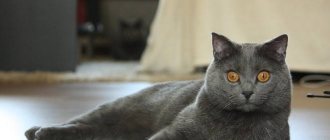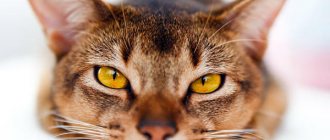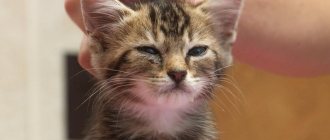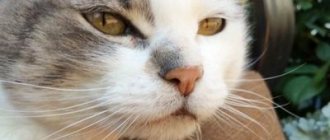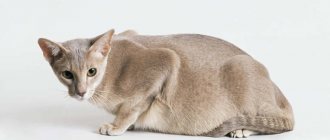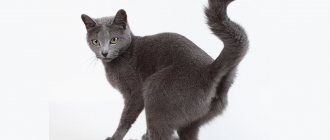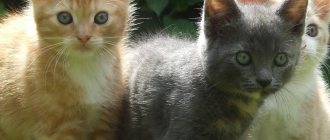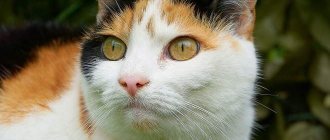An animal's nasal discharge is an attempt by its body to get rid of a pathogen or allergen. Often, secretion from the nose is accompanied by sneezing, impaired nasal breathing, and the cat may open its mouth slightly to breathe. The animal often licks its nose and the area around it. The fur near the nose becomes damp. Nasal secretions may contain blood.
It must be remembered that nasal discharge in cats cannot be ignored and the situation cannot be left to chance. For a cat, the nose is an organ with which he analyzes the world around him. Without a keen sense of smell, it’s difficult even for a domestic cat.
Is nasal discharge a cause for concern?
If your cat's sneezing and/or nasal discharge is minor and she has a normal appetite and activity level, you just need to monitor her condition. To be on the safe side, it is better to isolate a cat with a “running” nose from other animals.
Chronic nasal discharge is a common symptom of viral and bacterial infections and should be taken seriously. However, most often, nasal discharge is associated with food or seasonal allergies.
Treatment of a runny nose
In order to cure rhinitis in a cat, it is necessary to consult a veterinarian, because he will not only help relieve snot as a consequence of the disease, but will also help fight the cause that caused it. Treatment depends on what the pet is sick with. A diagnosis can only be made if the necessary tests are obtained and then the veterinarian will prescribe the appropriate treatment, for example:
- If the animal cannot breathe at all, then it needs to be given urgent assistance: to free and clean the nasal passages with the help of rinses.
- Sometimes, if a kitten is dehydrated, an IV will have to be given.
- In order to prevent secondary infection from occurring, it is necessary to conduct a course of antibiotic therapy.
- Treatment of a runny nose is carried out using the drug Dioxycycline in the appropriate dosage.
- Fosprenil in the appropriate dosage.
- If your cat has a stuffy nose, you can rinse with baby Naphthyzine in the appropriate dosage as prescribed by the veterinarian.
- For treatment purposes, a technique such as quarantine and constant change of litter, as well as avoidance of drafts, is needed.
Treatment at home
If it is not possible to visit a veterinary clinic, you can treat it at home in the following ways:
- Treatment with warming has proven itself well. To do this, you can use warm salt or sand poured into a bag.
- You can wash with Boric acid and zinc sulfate.
- It is good to treat rhinitis with saline injections.
- Treatment with beetroot juice dripped into each nostril will help with a runny nose.
- If the animal cannot breathe due to nasal congestion, then it can be treated with saline and Ecmonovocillin.
- Streptocide, previously ground into powder and blown into each nostril of the cat, helps relieve the inflammatory process.
- If the pet has a serious condition due to the inability to breathe, then it can be instilled with children's Galazalin.
If a cat has problems with its nose and cannot breathe calmly, then you need to visit a veterinary clinic, only there they will help you decide on the right treatment.
Allergic rhinitis in cats
If you observe watery discharge accompanied by sneezing, it usually means your cat has ingested or inhaled an allergen from the environment. Allergies to non-food irritants, also known as atopy, were most likely inherited by your cat from her parents.
Note! Atopic allergy is an increased sensitivity to common allergens: plants and their waste products, mold, insect bites and dust mites, etc.
Cancer (neoplastic)
Various types of cancerous tumors occur in the nasal cavity. The most common type in cats is adenocarcinoma, but other types, including soft tissue sarcoma and lymphoma, also occur. Cancerous tumors can cause problems in one or both nostrils. Possible deformation of the muzzle. Usually, with neoplasms in an animal, changes can be seen on MRI or CT. Ultimately, to determine the type of tumor, it is necessary to do a biopsy, taking a piece of tissue for histological examination (evaluating a section of tissue under a microscope), or a puncture for cytological examination (evaluating cells in a smear). Treatment for cancer depends on its type. Endoscopic removal of the tumor, rhinotomy, radiation and chemotherapy are likely.
Viral or respiratory diseases in cats
Thick and mucous discharge is a sign of a respiratory infection. It is important to understand that there are a lot of such infections and the diagnosis must be made by a veterinarian.
Viral diseases of cats that cause rhinitis:
- Actinomycosis.
- Viral peritonitis.
- Hemobartonellosis.
- Viral immunodeficiency.
- Calicivirus.
- Giardiasis.
- Mycoplasmosis.
- Panleukopenia (distemper).
- Parvovirus.
- Rhinotracheitis or herpes virus infection.
- Chlamydia.
A bacterial infection can cause chronic nasal discharge. If the discharge is thick, yellow and has an unpleasant odor - a bacterial infection, this is the most likely diagnosis.
Symptomatic diet and procedures
To make it easier for an animal to breathe before going to the hospital, its nasal passages must be cleared of crusts. This can be done using cotton wool and baby oil. You can soak the crusts using saline or boric acid (2% solution can be purchased at the pharmacy). The animal may resist when you help it, so you should wrap it in a blanket and hold it under your arm, or use the help of another family member.
Wet cleaning of the room and humidification of the air will help make nasal breathing easier for your animal; you can take your cat with you to the bathroom. While you take a shower or bathe, the cat will breathe moist air.
If the animal refuses to eat because it does not smell the aroma of the food, the food can be heated a little to enhance the aroma or poured with liquid from canned tuna to stimulate the animal's appetite.
It is important to provide the animal with constant access to clean water at room temperature.
In order for an ailment such as nasal discharge to occur to the animal as rarely as possible, it is important to carry out measures to generally strengthen the body. This is first of all:
- Adding active dietary supplements and vitamins to the diet.
- High-quality balanced nutrition.
- The use of general strengthening drugs, such as gamavit, immunofan, fosprenil, ibotan. Your veterinarian will help you calculate the dosage of medications.
You shouldn’t treat even the most harmless rhinitis in your pet. Frequent complications of untreated rhinitis are otitis (with subsequent complete loss of hearing), deformation of the muzzle, sinusitis, penetration of infectious agents into the brain (this condition threatens the life of the animal).
Take care of your pets, treat their illnesses on time!
Progression of chronic rhinitis
Regardless of whether the infection is viral or bacterial, the first discharge is watery and thin, and after 24–72 hours it becomes thicker, colored, and may acquire an unpleasant odor. In advanced stages of the disease, purulent discharge is observed.
Common causes of sneezing and chronic rhinitis in cats:
- Upper respiratory tract infection.
- Allergies or irritation of mucous membranes, for example, from smoke, dust, cleaning products, air fresheners, household chemicals.
- Diseases of the oral cavity and teeth.
- Foreign object in the nasal passage, polyps, neoplasms.
The cause of nasal discharge that periodically appears and goes away may be worms. Moreover, there are parasites whose eggs mature in the respiratory tract. The larvae hatch and begin to move, which irritate the respiratory tract, causing coughing, nasal discharge, sneezing and general malaise.
Secondary chronic rhinitis in cats
Cats are created to be unique and versatile. Wild animals keep their senses and teeth constantly clean. Domestic cats receiving an adapted diet do not have this opportunity. It is for this reason that more than 80% of cats over the age of 6 suffer from:
- Caries.
- Tartar.
- Various gum diseases.
Dental problems are a common cause of chronic nasal discharge in cats. Contact your veterinarian if you observe the following symptoms:
- Careful chewing or refusal to eat.
- Salivation.
- "Champing."
- Unpleasant odor from the mouth.
- Discharge from the eyes.
- Cough.
- Temperature increase.
- Ulcerative gum disease.
Another alarming symptom is noisy breathing through the mouth. Most often, open-mouth breathing indicates complete blockage of the nostrils. A similar picture can be observed when:
- Nasal congestion.
- Reporting.
- Neoplasms, including polyps.
Nasal infections can affect both your cat's overall health and her sense of smell. Nasal infections of a viral and bacterial nature can be “identified” by the following symptoms:
- Sneezing.
- Souring of the eyes.
- Refusal of food.
- Fever.
- A sharp decrease in activity.
Copious nasal discharge is observed with the following viral diseases:
- Herpes.
- Rhinotracheitis.
- Plague.
Note! Nasal discharge may be the first symptom of conjunctivitis, as the mucous membranes of the eyes and nose “communicate.”
Causes of colds
Clear discharge in an animal cannot be caused by a cold, since animals simply do not get sick from it. Your cat may have clear fluid coming from his nose due to:
- Poor nutrition. The lack of vitamins, essential microelements and nutrients leads to weakened immunity in cats. The pet needs to eat a balanced diet at the same time;
- Infections. If the immune system is weakened, the virus easily penetrates the pet’s body, undermining its health;
- Poor living conditions. High air humidity and low room temperature can trigger the disease. The most comfortable temperature for a pet is 22 ⁰ C. The animal also gets sick after hypothermia and long walks in winter or in the rain. To prevent this from happening, you need to wipe the cat with a terry towel.
Most often, animals get sick due to a virus that has entered the body. If a cat’s eyes and nose are running (eye festering), then he has definitely caught the virus.
In what cases is the help of a veterinarian needed?
- Sneezing and nasal discharge for 3 or more days.
- Intensive deterioration of the condition - the cat sneezes more often, the nose runs more strongly.
- The color and/or consistency of nasal discharge changes.
- Green, yellow, black, or bloody nasal discharge.
- Itching in the muzzle area.
- Noisy or hoarse breathing, snoring.
- Decreased appetite and activity level.
- Vomit.
- Photophobia.
- Fever.
- Anemia of the mucous membranes.
- Noticeable deterioration in wool quality.
- The appearance of crusts, cracks, scabs on the skin of the nose.
- Discharge from the eyes.
What causes a runny nose in cats?
There are several reasons. They are caused by improper nutrition and care of the animal, arise as a result of infection, or are a concomitant disease with oncology or other serious pathologies.
- Purebred pets often suffer from allergic rhinitis. This is how their body reacts to plant pollen, chemicals, medications, cleaning products, and cosmetics.
- A runny nose can be one of the signs of a serious infectious disease - pneumonia, tuberculosis.
- Rhinitis sometimes appears in an animal after prolonged hypothermia, ingestion of cold food or water.
- Hot air and steam can cause a runny nose. When a cat is near boiling water for a long time, or its fur is dried with a hairdryer, its body may react with acute rhinitis.
- The presence of foreign objects (fluffs, grains of sand) in the nasal passages also causes a runny nose.
- Oncological diseases that are localized in the nasal passages.
Foreign bodies
When foreign materials enter the nose, inflammation and irritation may develop around them. Sometimes foreign material can be seen during rhinoscopy. In some cases, foreign objects can be removed from the nose using grasping instruments or rinsing. To rinse the nose of an animal under anesthesia, a liquid (saline solution) is injected. Sometimes visual examination methods: CT or MRI are required to detect foreign material.
Diagnostic methods
As discussed above, various methods are used to diagnose the cause of nasal abnormalities. A complete examination for nasal disorders includes:
- MRI or CT - these highly effective visual diagnostic methods can better distinguish the details of the nasal cavity than x-rays.
- Rhinoscopy is an examination of the nasal mucosa (the outermost layer) using a rhinoscope.
- A biopsy of tissue from the nasal cavity for histological examination (where a histologist examines the tissue under a microscope) and microbiological culture.
These procedures are performed under anesthesia, so additional baseline blood tests are often required to ensure the absence of systemic disease. If systemic diseases are present, it may be necessary to change the drugs used for anesthesia.
- Complete clinical analysis to evaluate red blood cells, white blood cells and platelets.
- Biochemical analysis - assessment of liver and kidney function indicators, protein concentrations, electrolytes.
- Urinalysis - assessment of liver and kidney function.
- Blood pressure measurement. We try not to biopsy tissue from the nasal cavity if the patient has high blood pressure, since this makes it more difficult to stop the bleeding.
- Coagulogram is a blood test for clotting. It is important to make sure that the blood is capable of normal clotting before performing a biopsy.
- Chest X-ray. We recommend a chest x-ray to identify possible spread to the lungs and to ensure that there are no other lung problems that could increase anesthetic risk.
- Echocardiography is mandatory for all cats to exclude structural and hemodynamic pathologies.
